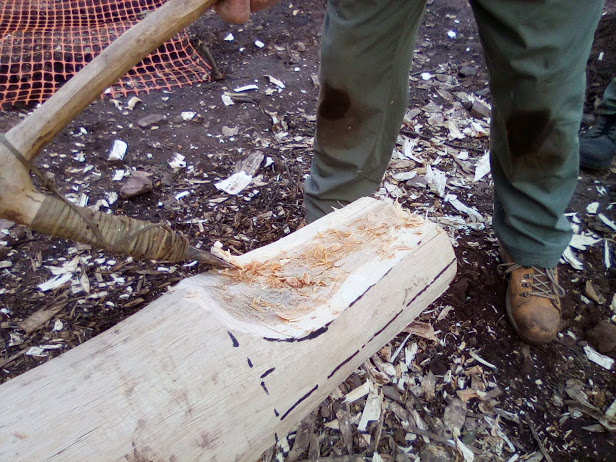25th – 29th February 2019
Phase 1 Construction Week 2
The weather is incredible with unseasonable warmth and sun bathing the tor in golden light. This week, the remaining posts and wall plate timber have arrived and we have begun to cut joints and to prepare the new timber ready for use.

This project is using locally gather materials that are far from standard in size or shape and as such we have to work with each piece of timber to find its specific location within the structure. The joints used to link these timbers reflect their individual properties. Work is progressing well with the three central posts. These the joints in these timbers reflect their individual characteristics.

Post CP14 has a very knotty top that does not lend itself to creating a tenon peg, so the volunteers have cut in two deep mortises to house the ends of the triangular purlins that will meet there. Mortise 1 was completed entirely with bronze tools and recorded in detail.

The efficiency of the tools surprised the volunteers, as did their capability for accuracy and refinement. The mortise took 108 minutes to complete (total working time), a staggering 13,124 blows using bronze tools, with an average removal of 0.12 cubic centimetres per blow. The final mortise is impressive. We are fast approaching the technical challenge of raising this 6 metre oak post into the ground and orienting it to the exact position for the mortise to support the purlins in the correct place.
Wall posts are also having tenon pegs cut into their tops to locate and support the wall plates that will eventually link them together.

Our aim this week is to have most of the posts jointed and ready to lift into position in the first half of the next project week. That will then leave us time to joint and fit the wall plates and purlins that will make the basic structure sound.

The volunteers have tried various methods to achieve the round pegs, but general consensus has settled on the cutting of flat surfaces to form a square peg – then rounding off the corners. The results are impressive and, timber allowing, relatively fast.

We have also been gathering some comparative data regarding tool efficiency. This has involved cross cutting logs with the same circumference using steel and bronze tools to understand how our ancient tool types perform.

All in all, we have had a very productive week and now stand ready to spend the next session hauling the posts into upright positions! After all of the initial labour intensive work of bark stripping, cutting to length, and jointing, the structure will suddenly burst into life!
